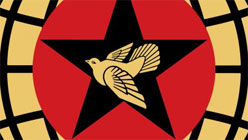Back in the 1980s, at the height of the AIDS crisis, a series of posters and billboards appeared with the words “DON’T SHARE” in red letters above an image of a syringe. A direct, simple, and most likely effective message discouraging intravenous drug users from sharing needles, the campaign was also, for me, a very potent expression of the Reagan “revolution.” Alongside “just say no,” the Reagan administration’s own big slogan at the time, “don’t share” communicated a double message, one that applied directly to a particular situation and another that tapped into the era’s zeitgeist, followed by the much more direct “greed is good” a few years later. While it was important to remain self-contained (at least where body fluids were concerned), sharing was actually the only effective way to combat the mysterious and deadly health epidemic that was AIDS. The community — under attack — pooled resources to both care for the sick and dying and to act up, fight back and force the government into action.
Antonino D’Ambrosio’s new film, Let Fury Have the Hour begins in the 1980s, quickly outlining how the “insane individualism” that Ronald Reagan and Margaret Thatcher worked so hard to normalize transformed citizens — with rights and responsibilities — into consumers whose only purpose was to shop. This ideology came to its fullest expression with the recent financial meltdown, the rise of the Tea Party, ongoing arguments over debt ceilings and fiscal cliffs and in much of the rhetoric Mitt Romney used during his failed 2012 bid for the presidency.
Let Fury Have the Hour is a reaction to struggle that thankfully locates art and artistic expression at the center of the melee. After all, the Reagan revolution coincided with the huge expansion of the art market, which created the impression that art was a luxury good produced for and only available to the elite. By the logic of the art market, the thought that art can change the world is folly. D’Ambrosio’s film rebuts this idea by showing how profound change can be inspired by cultural production. His main idea, which he calls “creative response,” is “just as an artist has to be able to look at things and see them slightly differently — see how the sun and the shadows fall — we have to approach everyday problems creatively.” The film portrays artists as world citizens creating works that transcend borders and have the ability to alter perspectives and inspire change.
The star-studded production includes Shephard Fairey, who made the graphics and Wayne Kramer (MC5) who composed original music for the film, which is jam packed with great tunes by The Clash, Public Enemy, Gogol Bordello, Fugazi and more. Let Fury Have the Hour is a dense collage of visuals and voices, including a chorus of musicians — Chuck D (Public Enemy), Tom Morello (Rage Against the Machine), Ian MacKaye (Fugazi), Billy Bragg and Eugene Hutz — writers, filmmakers, comedians and activists — Eve Ensler, John Sayles, Lewis Black, Edwidge Danticat, to name a few. Included in the mix are Bay Area locals Sean Hayes, Tommy Guerrero and Boots Riley (The Coup), but the whole enterprise looks and feels like it came straight out of the East Bay, lefty and somewhat heady Berkeley wisdom feverishly presented with a skateboard punk/found footage film edge.


